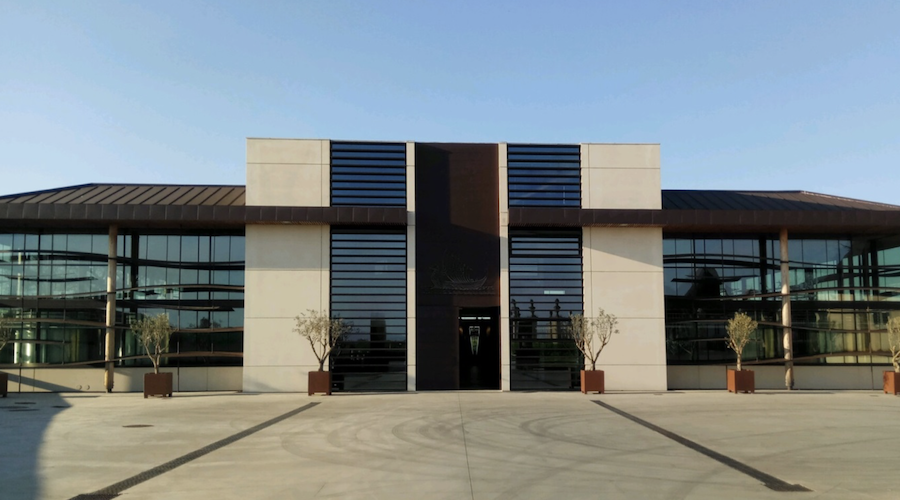Bordeaux 2018 vintage – the character of the vintage
by CloMlr
2019-04-08

Given the climatic conditions of the Bordeaux 2018 vintage described in an earlier post here – what impact did this have on the wines produced?
The new chai in Beychevelle which was used for the first time in 2016 and which helped to manage the 2018 vintage.
©Fabian Cobb / Wine Owners
The generic statistics fail to reveal the arduous nature of the vintage for the vine growers and whilst the widespread difficulties left their imprint on the wines the essentially dry and hot summer which lasted through to the autumn brought a phenolic ripeness to the fruit and permitted the chateaux to harvest in conditions almost unseen for decades.
The three main issues in the Bordeaux 2018 vintage:
Devastating phenomena such as hail which continued late into the year
Mildew – a threat which persisted until early summer
Drought-like conditions in the summer and autumn
Hail, as large as tennis balls, arrived in Bordeaux in May. The devastation it wrought on some vineyards was total and some estates will produce no wine from this vintage. Others were luckier although it reduced their crop. Some vines, incredibly, although struck by hail, managed to repair themselves. For one estate this was only the third time in 30 years hail had struck First floors – not an easy phenomenon to manage.
Given the persistent rain the mildew was extensive in Bordeaux in 2018. The warm almost tropical weather in June followed by further outbreaks in July brought huge casualties across Bordeaux. This was a year of firsts. Managers had rarely if ever seen such extensive ground rot and one estate in Margaux lost two-thirds of their crop overnight. This reduced the remaining crop to one bunch per vine. A common way for estates to deal with the threat of mildew is to de-leaf the vine permitting air to circulate and dry out the plant. However, the canopy might be needed later (as it turned out) and if this effeuillage was too drastic the consequences would be felt later on. Maintaining a canopy might also help to maintain the freshness and fruit. As it turned out, the second half of the year needed to use the resources (water) of the first part. Without this water it would have been a very different vintage.
Once the anti-cyclone established itself over the region the grapes matured with a richness unseen before. This in itself meant additional care at harvest time. One estate manager commented that the change in conditions from the end of July to when people returned from their holidays in August was ‘spectacular’. Something he ‘had never witnessed in the 25 years or working on the estate’. Not only that but the meteorological forecast was ‘extraordinary’ – and was fulfilled.
Given the replenishment of the water table the remaining harvestable crop was of outstanding quality. Merlot berries were normal size because their growth cycle coincided more with the presence of water in the soil but the Cabernet Sauvignon were small and concentrated – but not ‘cooked’ nor ‘confit’.
Some estates might produce normal or near-normal yields but 20-30% less was common, 50% not uncommon, with some reduced to 10hl/ha - a volume not seen since the 60s.
Judging maturity is probably the most important factor to produce a good wine. Undoubtedly, given the richness of the grapes this was going to be another area of distinction for the various estates – when to harvest? Ironically, some estates decided to harvest early to preserve acidity (one source of freshness). But it’s not clear this was a functional objective. As one technical manager told us, ‘some estates near them were harvesting 10 days earlier than them, when normally they would be harvesting a week later. Clearly, a disparity in vision. When the harvest did come in, there were still summer conditions and, if they could, estates cooled the fruit down before it was processed. Realising the grapes were rich, extraction would need to be managed ‘almost by itself’. Reducing the temperature of fermentation was a more common technique along with less pigeage or remontage, for example, and other techniques often employed to extract more. This helped to preserve the fruit and freshness. Tannins dissolve more in higher alcohol solutions - extracting the polyphenols wasn’t going to be a problem in 2018. Some estates had the highest IPT (Indice de Polyphénols Totaux) of any year on record.
The successful red wines from the Bordeaux 2018 vintage (and there are a lot less of those than expected) are dense, deep coloured almost opaque in cases. The benchmark 2018 nose is red fruit driven with some chocolate and coffee aromas. The pallet is full and round, and the tannins have the potential to be silky. Surprisingly, the wines have maintained a degree of freshness. The wines are structured with unusual body. It is a good year for the dry whites which have preserved good acidity and are perfectly ripe. The sweet whites are concentrated and rich but lack the complexity of really good years due to the late arrival of botrytis – it was simply too dry.
A model of the new chais currently underway at Chateau Figeac
©Fabian Cobb / Wine Owners
Posted in:
Fine wine appreciation,
Tags:
#bdx18, Bordeaux, Bordeaux 2018, Bordeaux en primeur, Chateau Beychevelle, Chateau FIgeac, en primeur, fine wine, wine, winemaking,

